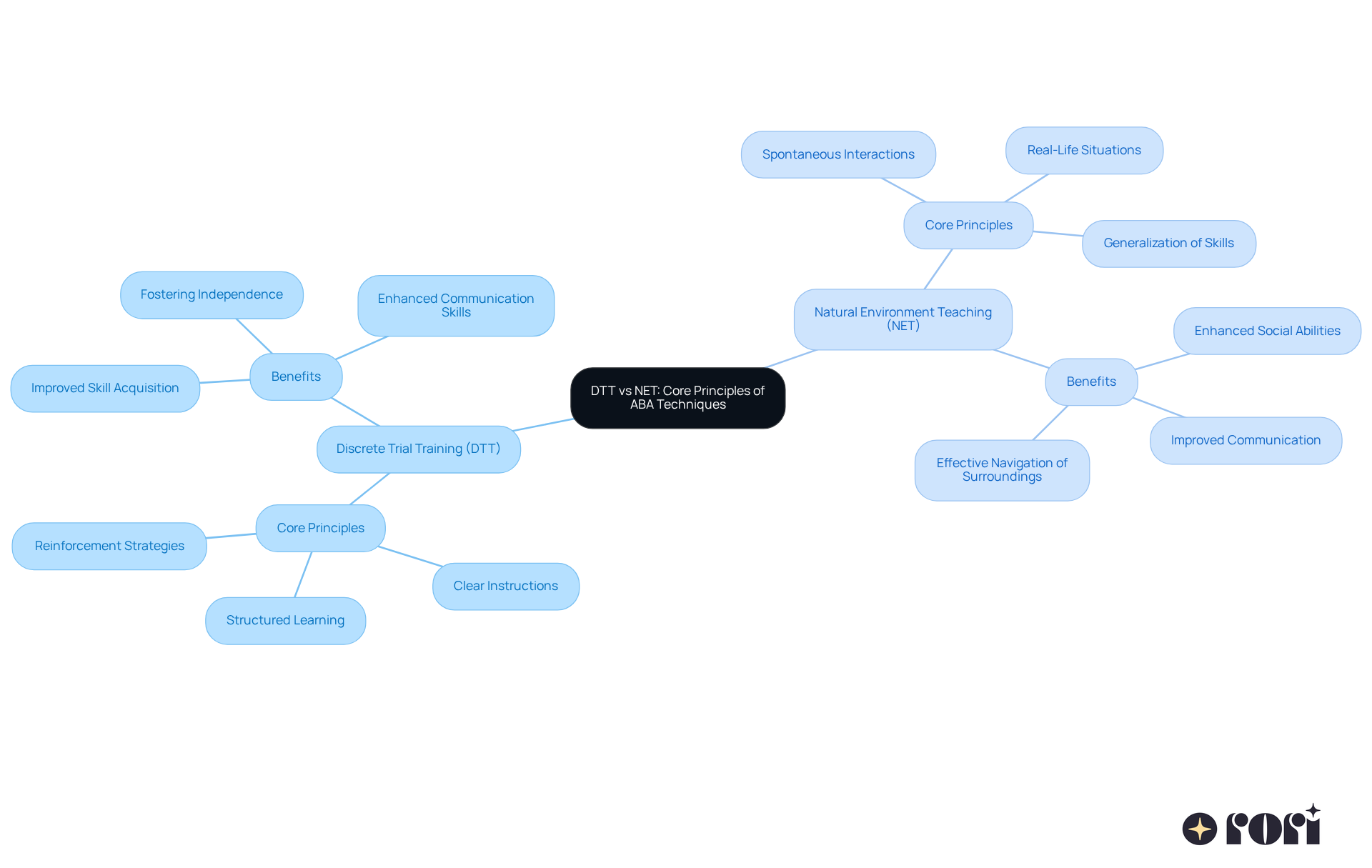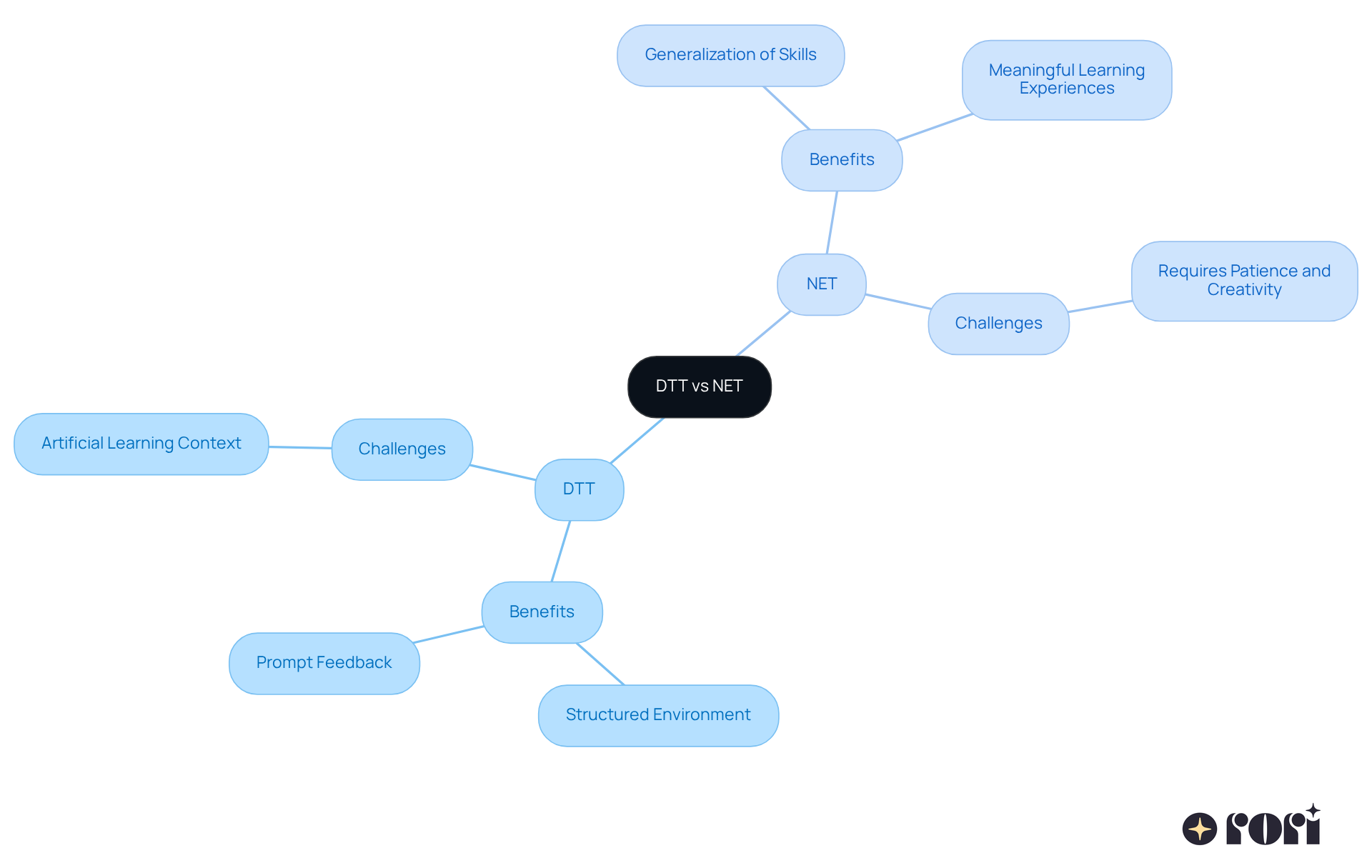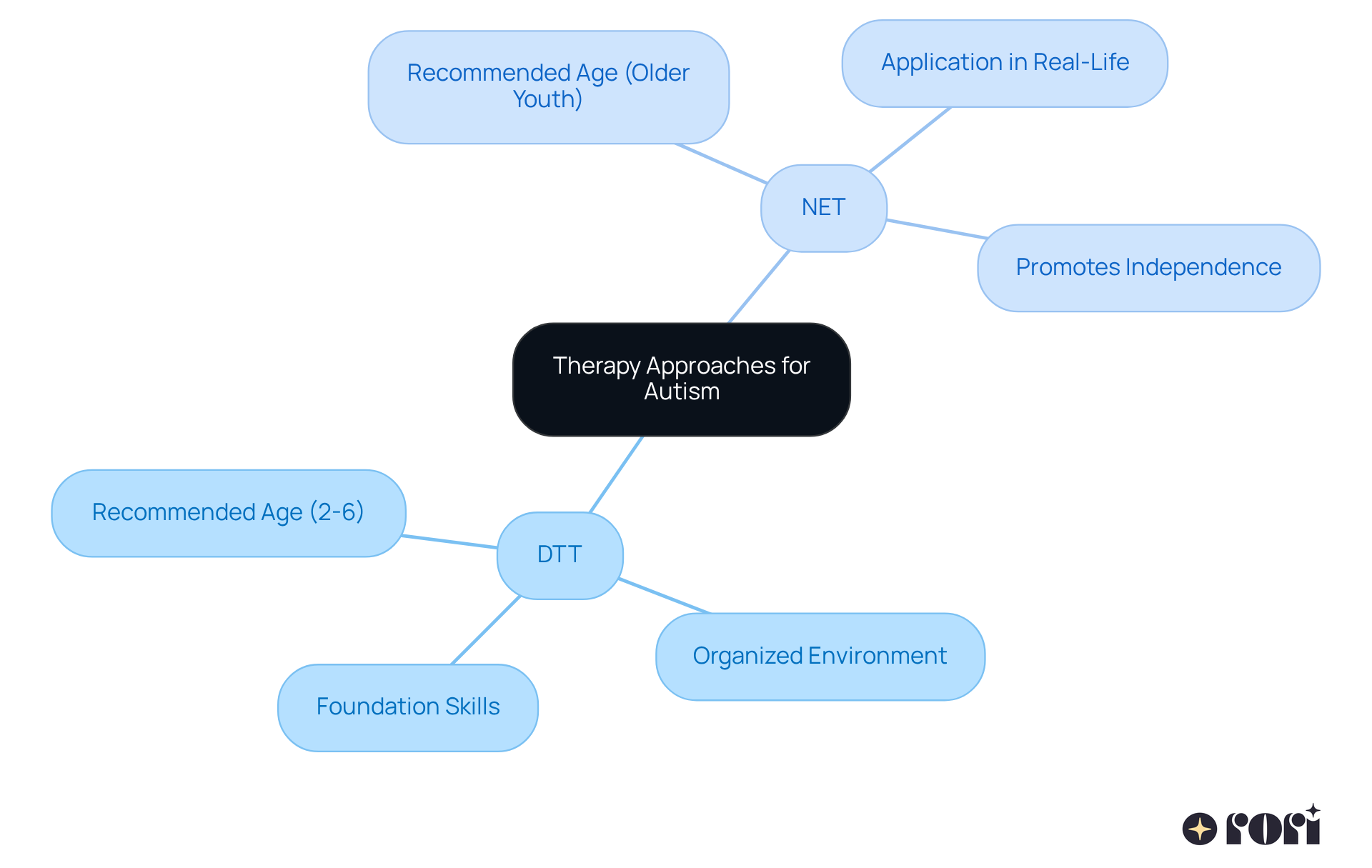In this article, we explore two distinct methodologies in autism care: Discrete Trial Training (DTT) and Natural Environment Teaching (NET). Both have their unique benefits, and understanding these can help you make informed choices for your child.
DTT is fantastic for structured skill acquisition in controlled settings—think of it as a classroom where skills are taught step by step. On the other hand, NET shines when it comes to promoting skill generalization in real-life contexts, allowing skills to be practiced in everyday situations.
What’s really exciting is that you don’t have to choose one over the other! Integrating both DTT and NET can provide a comprehensive approach tailored to the developmental needs of individuals with autism. Let’s explore this together and find the best path for your child’s growth!
The landscape of autism care is evolving, shaped by a variety of teaching methodologies that each bring their own unique advantages and challenges. Among these, Discrete Trial Training (DTT) and Natural Environment Teaching (NET) shine as two prominent approaches within Applied Behavior Analysis (ABA). Both are designed to help individuals with autism acquire and generalize skills, but they do so in different ways.
As practitioners and caregivers explore these methods, a crucial question emerges: how can they blend DTT's structured learning with NET's real-world application to enhance developmental outcomes? This exploration dives into the key differences and benefits of DTT and NET, offering insights that could truly transform autism therapy practices. Let’s explore this together!
Discrete Trial Training (DTT) is a systematic teaching approach based on Applied Behavior Analysis (ABA) that breaks down abilities into smaller, manageable components. Each ability is taught through distinct trials, where educators provide clear directions, prompts, and reinforcement for accurate responses. This organized method is especially beneficial for cultivating essential abilities, such as communication and social engagement, within a regulated setting. Research shows that when comparing DTT vs NET, DTT greatly improves skill acquisition, fostering independence and social abilities in individuals with autism.
On the other hand, Natural Environment Teaching (NET) utilizes a young person's natural surroundings to promote education. This method emphasizes spontaneous interactions and real-life situations, making the learning experience more relevant and engaging. NET seeks to generalize abilities gained in structured environments to everyday situations, thus improving the individual's capacity to utilize these abilities in real-world contexts. Case studies show that youngsters who participate in NET exhibit enhanced communication and social abilities, as they learn to navigate their surroundings effectively.
By examining the differences in DTT vs NET, practitioners can develop a comprehensive strategy that optimizes developmental results for individuals with autism. Key features include:
This comprehensive approach addresses both structured learning and real-world application, ensuring that each individual receives the most effective support tailored to their personal journey. Let’s explore this together!

In practice, Discrete Trial Teaching (DTT) uses a systematic method to teach abilities in a controlled setting, often at a desk or table. Each trial includes a clear instruction, a prompt if needed, and reinforcement for correct responses. This approach is great for teaching specific skills that require repetition and consistency, making it especially effective for young children under 5 with autism. Customized curricula created by experts in early intervention really highlight its effectiveness. Plus, caregiver education is key! When caregivers are informed, they can better support their children's development by reinforcing these skills at home, which promotes consistency and enhances the overall effectiveness of DTT. This involvement also helps reduce caregiver stress and improves family interactions, creating a more supportive atmosphere for the little ones.
On the flip side, Natural Environment Teaching (NET) takes place in a child’s natural surroundings, allowing learning opportunities to arise organically. For instance, a therapist might use a child’s interest in toys to teach language skills during playtime. This method encourages kids to engage with their environment, making learning feel more meaningful and applicable to everyday life. Caregivers who understand ABA principles can actively participate in these sessions, making informed choices that positively impact their child’s progress. NET allows young learners to gain knowledge in various natural settings, enhancing the relevance of the skills being taught.
In comparing DTT vs NET, it is evident that while DTT is effective for isolated skill acquisition, NET promotes the generalization of skills across different contexts, helping children apply learned behaviors in real-world situations. Integrating both methods can significantly enrich the learning experience, particularly in the context of DTT vs NET, as they complement each other by blending structured skill teaching with relaxed, generalized learning. As noted by InBloom Autism Services, using both DTT and NET provides a well-rounded ABA program tailored to each child’s needs, ultimately empowering caregivers and improving behavioral outcomes. Let’s explore this together!

DTT offers some great benefits! It creates a highly structured environment, which can be especially helpful for children who thrive on routine and predictability. Plus, it allows for prompt feedback and reinforcement, making it easier for kids to understand and retain new skills. However, one challenge with DTT vs NET is that it might not encourage kids to apply what they learn in real-life situations, as the learning context can feel a bit artificial. This is where caregiver education becomes so important! By equipping caregivers with ABA principles and strategies, they can support their child's development at home, ensuring consistency and reinforcing the skills learned during DTT sessions.
On the flip side, when comparing DTT vs NET, it is evident that NET promotes the generalization of skills by teaching in authentic environments. This approach often leads to more meaningful learning experiences. Children are more likely to engage with and remember skills learned in contexts that relate to their daily lives. Caregiver involvement is key here too! When caregivers understand the concepts behind NET, they can create opportunities for learning in everyday situations. However, it’s worth noting that NET might require more patience and creativity from therapists, since educational opportunities can be less predictable and structured compared to the differences outlined in DTT vs NET. Empowered caregivers, guided by their education, can navigate these challenges effectively, enhancing their child's overall development. Let’s explore this together!

DTT is often recommended for younger kids, especially those aged 2 to 6, because it provides an organized environment that's essential for learning basic skills. The clear expectations and consistency that come with DTT are really important for little learners who are just starting to build their foundational abilities. But as kids grow and their educational needs change, the comparison of DTT vs NET becomes more suitable, especially for helping them use their skills in real-life situations.
In the discussion of DTT vs NET, it is evident that NET shines for older youth and those who have already built foundational skills through DTT. This approach helps them apply what they've learned in natural settings, promoting independence and boosting social adaptability. Developmental psychologists emphasize that as kids mature, their therapy should shift toward methods that encourage generalization and practical use of skills. One psychologist notes, "As youngsters move into older age categories, it is crucial that their therapy mirrors their increasing necessity for practical application of abilities," highlighting the importance of customizing therapy to meet each child's unique needs.
With the growing demand for effective autism therapies, as seen with organizations like Space4Autism, a blended approach comparing DTT vs NET for initial learning and generalization might offer the best results in autism care. This strategy aligns with the principles of Applied Behavior Analysis (ABA) therapy, which focuses on individual needs and has shown significant progress in 90% of individuals when caregivers are actively involved. Plus, ABA therapy is the only scientifically backed treatment for autism that's covered by insurance, making it more accessible for families. Case studies, like those from the SHANARRI School initiative, show how combining these methods can support children's development as a whole and help them gain independence through essential skills. So, understanding the developmental aspects of implementing NET is key to optimizing therapy outcomes. Let’s explore this together!

When we look at the differences between Discrete Trial Training (DTT) and Natural Environment Teaching (NET), it’s clear that each method has its own special benefits designed to meet the developmental needs of individuals with autism. DTT offers a structured framework that works wonders for early skill acquisition, while NET focuses on using those skills in real-life situations, helping children become more independent and socially adaptable.
This article highlights some important points, like the need for personalized planning, measurable goals, and evidence-based strategies in both methods. DTT shines when it comes to giving clear instructions and prompt feedback, making it a great fit for younger children. On the other hand, NET encourages meaningful learning through spontaneous interactions in natural settings. By blending both approaches, we can really boost the effectiveness of autism care, creating a comprehensive strategy that balances structured learning with practical application.
Ultimately, choosing between DTT and NET isn’t just a black-and-white decision. It’s about finding a complementary relationship that suits each child’s unique journey. By understanding the strengths and limitations of both methods, caregivers and practitioners can craft a balanced approach that maximizes developmental outcomes. Embracing this blended strategy not only empowers caregivers but also enriches the learning experiences for children with autism. Together, we can pave the way for a more inclusive and effective therapeutic environment. Let’s explore this journey together!
What is Discrete Trial Training (DTT)?
Discrete Trial Training (DTT) is a systematic teaching approach based on Applied Behavior Analysis (ABA) that breaks down abilities into smaller, manageable components. It involves distinct trials where educators provide clear directions, prompts, and reinforcement for accurate responses.
What are the benefits of DTT?
DTT greatly improves skill acquisition, fosters independence, and enhances social abilities in individuals with autism, particularly in structured settings.
What is Natural Environment Teaching (NET)?
Natural Environment Teaching (NET) utilizes a young person's natural surroundings to promote education, emphasizing spontaneous interactions and real-life situations to make learning more relevant and engaging.
How does NET differ from DTT?
While DTT focuses on structured, systematic teaching in controlled environments, NET aims to generalize skills learned in these settings to everyday situations, enhancing the individual's ability to use these skills in real-world contexts.
What are the key features of effective behavioral plans?
Key features include individualized planning tailored to the child's unique needs, measurable goals for behavior change and ability development, evidence-based strategies grounded in research, and ongoing evaluation and modification of treatment plans based on progress and caregiver involvement.
How do DTT and NET work together?
By examining the differences between DTT and NET, practitioners can develop a comprehensive strategy that optimizes developmental results for individuals with autism, addressing both structured learning and real-world application.